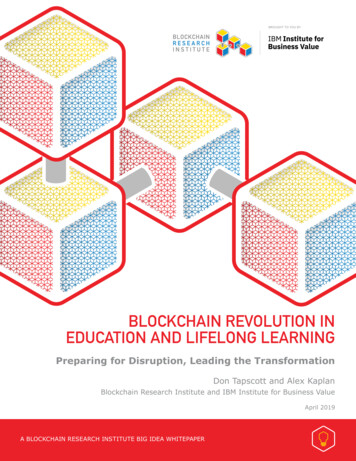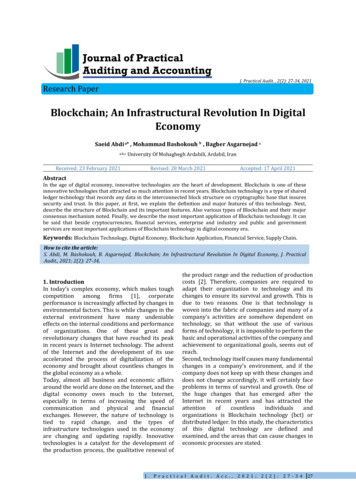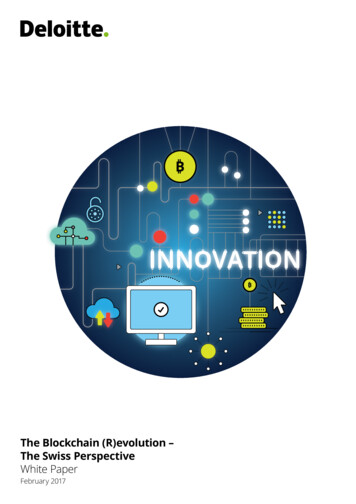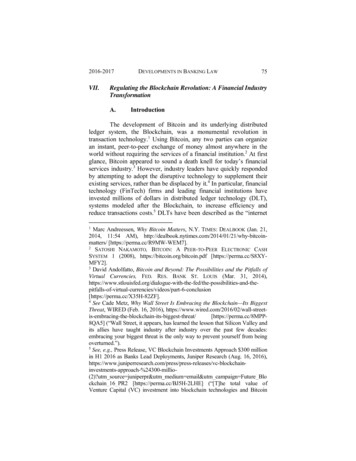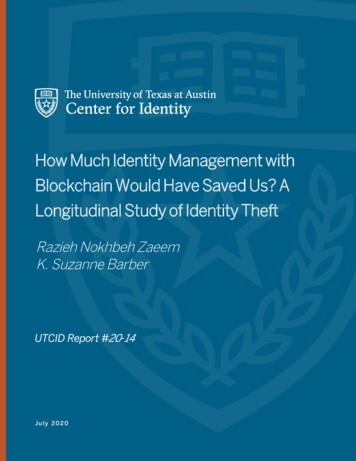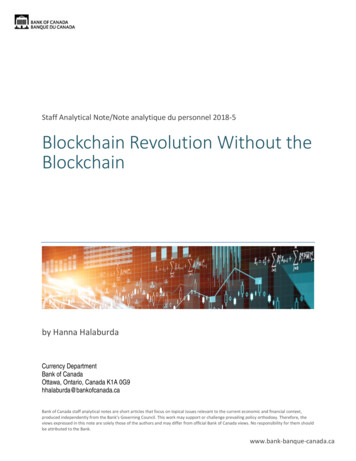
Transcription
Staff Analytical Note/Note analytique du personnel 2018-5Blockchain Revolution Without theBlockchainby Hanna HalaburdaCurrency DepartmentBank of CanadaOttawa, Ontario, Canada K1A 0G9hhalaburda@bankofcanada.caBank of Canada staff analytical notes are short articles that focus on topical issues relevant to the current economic and financial context,produced independently from the Bank’s Governing Council. This work may support or challenge prevailing policy orthodoxy. Therefore, theviews expressed in this note are solely those of the authors and may differ from official Bank of Canada views. No responsibility for them shouldbe attributed to the Bank.www.bank-banque-canada.ca
AbstractThe technology behind blockchain has attracted a lot of attention. However, thistechnology is for the most part not well understood. There is no consensus on whatbenefits it may bring or on how it may fail. A careful look into the technology finds thatmost of the proposed benefits of so-called blockchain technologies do not really comefrom elements unique to blockchain. Instead, they come from more conventionalelements such as encryption and smart contracts. Moreover, even those applicationsthat would benefit from a distributed system may benefit more from a distributeddatabase designed differently than blockchain.Bank topics: Digital currencies; Recent economic and financial developments; ServicesectorJEL codes: D8, G2, O3, O33RésuméLa technologie à la base de la chaîne de blocs suscite beaucoup d’intérêt. Or cettetechnologie, pour l’essentiel, n’est pas bien comprise. Il n’existe aucun consensus surses avantages ni sur ses défaillances possibles. Si on l’examine attentivement, onconstate que la plupart des avantages escomptés ne découlent pas d’éléments propresà la chaîne de blocs, mais d’éléments plus traditionnels, comme le chiffrement et lescontrats qui s’autoexécutent. De plus, même les applications qui profiteraient d’unréseau décentralisé pourraient bénéficier davantage d’une base de données partagéeconçue différemment de la chaîne de blocs.Sujets : Monnaies numériques; Évolution économique et financière récente; Secteur desservicesCodes JEL : D8, G2, O3, O33ISSN 2369-9639 2018 Bank of Canada
Blockchain—often called “the technology behind Bitcoin”—has attracted a lot of attention, perhapssomewhat comparable to that devoted to the Internet at the time of the dot-com boom. Many areexcited about this new technology, supposedly based on a public, permissionless, distributed ledgerthat cryptographically assures immutability without a need for a trusted third party and allows forsmart contracts. Large and small companies want to get on board, since they expect this technology tolower their costs by making transactions quicker, safer, transparent and decentralized.However, the technology behind the blockchain is for the most part not well understood. There is noconsensus on what benefits it may really bring,1 or on how it may fail.Optimism in the face of novelty and uncertainty of a new technology is not a new phenomenon, but itdoes affect the economy, for example, through optimistic valuations of blockchain-referencingstartups. This optimism also appears in estimates quoted by the media that indicate large cost savingsbut don’t offer much detail about how those savings would occur.A more careful look into the technology reveals that most of the proposed benefits of so-calledblockchain technologies do not actually come from blockchain. What gets bundled up as blockchaintechnologies—smart contracts, encryption and a distributed ledger—are separate concepts. The threemay be implemented together, but they do not need to be. We analyze them separately and arguethat most of the proposed benefits come from encryption and smart contracts. But encryption andsmart contracts do not need blockchain.So, while the wave of excitement may facilitate adoption of new technology solutions, the landscapeafter the so-called blockchain revolution may include very few actual blockchain applications. Instead,the changes could focus on encryption and smart contracts.Confusion around what blockchain actually isThe market’s excitement about blockchain technologies is growing and is perhaps best summarized inthe increasingly popular slogan “blockchain revolution.” It is estimated that the blockchain market size1For example, some pundits point to “privacy” while others to “transparency” as a benefitof blockchain.1
will grow from US 210 million in 2016 to over US 2 billion by 2021.2 Blockchain technologies areexpected to change the way the financial industry, supply chains, government record-keeping andmany other areas operate. The Financial Times 3 describes the technology as follows:Blockchain is an electronic ledger of transactions that are continuously maintained in blocks ofrecords. What gets its developers, investors and fans so excited, however, is that ledgers arejointly held and run by all participants. It is meant to be cryptographically secured to preventanyone being able to manipulate records, such as who voted for whom, or who owns a bankaccount.4The revolution is supported by a few forces, the most significant of which is the expectation ofsubstantial cost savings, as described in the following quotes from Financial Times:Blockchain is the electronic ledger originally built to underpin bitcoin markets. Promoters say itwill lead to cheaper, more secure ways of settling all kinds of transactions. 5The technology—an electronic ledger with records stored in “blocks”—aims to automate thecomplex networks of trust and verification on which modern finance sits, potentially cuttingtens of billions of dollars of costs from the financial sector.6The main sources of savings are supposed to come from increased security, faster transactions and ashared ledger. 7 Faster transactions on blockchain are often—but not exclusively—ascribed to smartcontracts (i.e., automated execution of transactions). A shared ledger is supposed to contribute to costsavings because blockchain is assumed to operate without a trusted third party and therefore toeliminate intermediaries.2As estimated by Markets and Markets, a market research company lockchain-technology-market-90100890.html). Market size is measured by revenues from sale of blockchainrelated solutions.3 It is worth noting that among all the media excitement, the Financial Times’ voice is probably the most cautious inblockchain matters.4J. Wild, “Blockchain believers hold fast to a utopian vision,” Financial Times, January 27, 2017.5G. Meyer and N. Hume, “Trafigura tests blockchain for settling US oil market deals,” Financial Times, March 27, 2017.6P. Stafford, “Blockchain consortium raises record 100m,” Financial Times, May 23, 2017.7 Additional expected benefits include public data and time-stamping of transactions.2
However, these assumptions about the benefits of blockchain seem to confuse at least three differentconcepts: (1) encryption, (2) smart contracts, and (3) distributed ledger, a type of a distributeddatabase. The three may be applied together. But they are separate tools, and not all of them arenecessary in a blockchain system.So, what is “blockchain”?While there is no one standard definition of blockchain, the most parsimonious and commonly used isa “distributed ledger of transactions.” 8 This is why the term “blockchain technologies” is often usedinterchangeably with “distributed ledger technologies.” This parsimonious definition allowsblockchains to have different attributes. Specifically, not every distributed ledger can be securewithout a trusted third party9 or needs to involve smart contracts. More importantly, encryption orsmart contracts do not require a distributed ledger (i.e., blockchain) to be implemented.Where is this confusion coming from?Confusion around blockchain can be traced to the origin of the term. The term “blockchain” wasintroduced as shorthand for a “chain of blocks of transactions,” which was part of the Bitcoin system.Therefore, in the Bitcoin context it meant a “distributed ledger of transactions.” Later, “blockchain”became an independent term in media discussions of whether there are other uses for distributedledgers of transactions beyond Bitcoin.Since it started in 2009, the Bitcoin system, which operates without a trusted third party, has beensuccessful in preventing fraud on its blockchain. 10 That is, Bitcoin’s blockchain has proved to be for allpractical purposes “immutable.” For this reason, it is often said to be secure. Bitcoin’s blockchain isalso public (all transactions are visible) and permissionless (any computer may participate in validatingtransactions and adding them to the ledger).8Note that a “ledger of transactions” is different from a “ledger of balances.” The former keeps the history of transactions,as in the “chain of blocks of transactions.” A ledger of balances wouldn’t be a blockchain.9Alternatively, one could insist on defining “blockchain” to be a distributed ledger that is secure without any trusted thirdparty. That is a more restrictive definition that would exclude most currently proposed applications of blockchaintechnologies.10While there have been thefts of large sums of bitcoins, e.g., on Mt.Gox, none of them occurred by falsifying theblockchain. The difference is akin to the difference between a bank robbery and counterfeiting in the realm of papercurrency. While “bank robberies” have happened in the world of Bitcoin, the system has proven to be resistant to“counterfeiting.”3
Some pundits erroneously extrapolate that any blockchain will have these properties: distributed,secure, public, permissionless and will operate without the need for a trusted third party. Thisextrapolation may come from an illusion that the Bitcoin’s blockchain properties come solely fromtechnology, while they actually come from a combination of technology and an incentive system thataccounts for the behaviour of human participants. Yes, the Bitcoin system uses cryptographic tools:public-private key encryption, hashing algorithms. But the system is virtually immutable 11 becausechanging the blockchain’s history is too costly.12Bitcoin’s blockchain has these properties because it is a part of the Bitcoin system. Other distributedsystems may not be able to sustain these properties. This is because the Bitcoin system is much morethan just the blockchain. The system also involves native cryptocurrency (bitcoins), mining and otherelements. Changing the elements of the system, e.g., by removing the native cryptocurrency, or bychanging the proof-of-work mechanism, affects the incentives of the participants and therefore mayalter the properties of the distributed ledger that is supported by this modified system.Note also that smart contracts are not a core property of the Bitcoin blockchain. The Bitcoin systemallowed for additional comments along with the transactions, which provided rudimentary capability tocreate code that would allow for automatic execution of some transactions. Ethereum expanded onthis feature, introducing a blockchain with the main purpose of facilitating smart contracts. 13Mainstream media’s use of the term “smart contracts” solely in the context of blockchain may havecreated the perception that smart contracts are native to blockchains. However, a code automaticallyexecuting a transaction can be implemented by a wide range of entities.Therefore, smart contracts, encryption and distributed ledger are separate concepts. They may beimplemented together, but do not need to be. The term “blockchain” should not be used as a catch-allaggregation of these different terms.Bitcoin’s blockchain is immutable with very high probability, but does not guarantee absolute immutability.The Bitcoin system makes adding a block to the blockchain artificially costly by making verification nodes compete tosolve a cryptographic puzzle. This also makes changing blockchain’s history prohibitively costly. Changing this feature, whileleaving all the cryptography in place, could jeopardize the safety of a blockchain operating without a trusted third party.13See www.ethereum.org.11124
Why is it important to consider smart contracts, encryption and distributedledger separately?The broadening of the meaning of “blockchain” to include smart contracts, encryption and distributedledger could simply reflect the evolution of a term in a living language. However, precision matters forestimating costs and benefits, or even for predicting the best uses of blockchain technologies. Smartcontracts, encryption and distributed ledger each bring different benefits. And since they can beimplemented independently, an optimal solution for a particular application may include only some ofthese tools but not others. This may matter for the future of the blockchain revolution.Smart contracts are computer programs that automatically implement the terms of an agreementbetween parties. One example typically given is that of a car lease: upon a missed payment, the carwould automatically lock and control would return to the lender. Since execution of a smart contractdoes not involve a decision or an action by a human, it may be faster and minimize the number ofmistakes. Both the increased speed and reduction in errors would result in cost savings.The term “smart contracts,” and the car example, come from Nick Szabo’s 1997 article, 14 published12 years before Bitcoin and its blockchain. Some media outlets state that “through blockchaintechnology, smart contracts are now a reality.” 15 However, smart contracts were a reality long before.An automated recurring payment that someone sets up with a bank is an example of a smart contract.Blockchain is not needed to gain the benefits from smart contracts, because smart contracts can be setup on a centralized system—a bank’s system or a platform dedicated to smart contracts used byindividuals.Encryption, which increases the security of a computer system, may also result in significant costsavings. 16 Currently, encryption is underutilized in business practice. For example, until recently public-14N. Szabo, “Formalizing and Securing Relationships on Public Networks,” First Monday, September 1997. Available view/548.15 See, e.g., A. Lielacher, “A Cost-Benefit Analysis of Using Smart Contracts in Banking,” BTCManager.com, April 14, 2017.Available at using-smart-contracts-in-banking/.16The security of Bitcoin’s blockchain comes from two sources: (i) encryption tools, such as public-private key, using hashfunctions, etc; and (ii) incentives induced by the mining scheme. We focus here on encryption. As we discuss later, theincentives induced by mining are difficult to sustain in blockchains without native cryptocurrency and without a trustedthird party (or parties).5
private key encryption was typically used to log into a business’s information technology system, butonce users were admitted into the system, there was some, but little protection.17Excitement about blockchain turned more attention to new developments in cryptography. Bitcoin’sblockchain uses standard, well-established cryptography tools (public-private key encryption, hashfunctions, etc.). But novel tools developed in recent years allow for much bolder uses. The premise isto create encryption systems that would protect the information—no matter where it is stored—ratherthan protect a specific computer.Serious efforts in this direction have already been undertaken by industry heavyweights, as stated byR. Martin Chavez, the chief financial officer of Goldman Sachs:We focused on encryption and key management, worked on these issues with AWS and Google,and now we are in a new state. Our developers are indifferent as to whether a particular datacompute load will happen out of Amazon and Google [cloud computing services] or whetherthey will happen in our own data centers. And we assume that all the computers are hostile; itdoesn’t matter whether they are at AWS or our own data centers.18This essentially describes a paradigm shift in the approach to cyber security, and we should payattention to it. Given the large sums currently spent in relation to fraud and hacking, this shift haspotential for significant cost savings. A 2016 study of large companies estimated that cyber crime coststhe average large US company US 17 million. The global average is US 9.5 million. 19 However, it isdoubtful that we need blockchain to get the benefits of encryption and to trigger these cost savings. 20What are the benefits of blockchain?The arguments above show how smart contracts and encryption can result in cost savings. But whatabout the benefits of distributed ledger, i.e., the blockchain itself?17For example, often, information is encrypted on specific drives in companies’ computer systems.R. M. Chavez, “Data, Computing, and Transformation in the Financial Industry,” speech at the symposium “Data, Dollarsand Algorithms: The Computational Economy,” Harvard Institute for Applied Computational Science, January 19, 2017.Available at https://www.youtube.com/watch?v VF6DrX9H0Ug .192016 Cost of Cyber Crime Study & the Risk of Business Innovation, Ponemon Institute Research Report, October 2016. Thenumbers are steadily increasing. In 2015 the average cost was US 15 million in the United States and US 8 million globally.20 The Goldman Sachs solutions described in the Chavez quote do not rely on blockchain.186
Distributed ledger allows multiple parties in the system to add transactions to a shared ledger in a waythat the changes are reflected consistently across all its copies. 21 It brings benefits in places wherereconciliation of contradictory ledgers is costly. At the same time, recording transactions on a sharedledger takes more time than on a centralized ledger because of the reconciliation mechanisms(consensus mechanisms) that need to be employed. Moreover, the need to store the copies of theledger in multiple locations may significantly add to storage and computational costs. To date, it hasnot been clearly demonstrated in which circumstances the benefits of employing a distributed ledgeroutweighs the cost of delays and duplicated storage.Moreover, with the experience of Bitcoin, proponents of blockchain technologies expect more fromthe new technology than just a distributed ledger. By looking at Bitcoin’s blockchain and the fact that ithas not suffered a breach since its inception, the pundits extrapolate that any blockchain by its natureoffers added security benefits beyond encryption. They also expect that adopting blockchain wouldresult in further cost savings due to disintermediation, since Bitcoin’s blockchain does not require atrusted third party to be virtually immutable. Indeed, the core of Bitcoin’s computer-scientificinnovation was the security of a permissionless distributed ledger, so that there is no need for atrusted third party anywhere in the system.22Distributed ledgers are a special type of distributed databases, which have been known and used forthree decades. But while previous distributed databases were permissioned and required a third partyto manage the permissions and help maintain the database, Bitcoin was the first that allowed for apermissionless distributed ledger. 23 So yes, Bitcoin’s blockchain is virtually immutable without a needfor a trusted third party.However, these benefits may be difficult to realize in a blockchain without Bitcoin. It has proven to bea challenge to create a decentralized, permissionless and secure blockchain to transfer assets otherthan a native cryptocurrency (for example, bitcoins for the Bitcoin blockchain).Technically, distributed databases also have other desirable properties, but this one seems to be the focus in the contextof blockchain technologies and fintech.22The security of the ledger is not guaranteed. However, the probability of a failure is pushed so low that the ledger isconsidered secure for all practical purposes. Nonetheless, there are factors that can affect this probability. Some are wellknown and discussed in the literature, such as the 51 per cent attack.23There were earlier, less successful tries to establish permissionless ledgers, e.g., bit-gold.217
The first major challenge is the gateway problem: the information about the underlying assets needs toenter the blockchain in the first place. For example, suppose we want to use a blockchain to record andtransfer land-ownership titles. To initiate this process, a gateway needs to attest that a specific plot ofland exists and to assign it to an initial owner. Whether the gateway is an individual, an institution or aconsortium, it needs to be a trusted third party for subsequent users of the blockchain. Importantly,Bitcoin does not need a gateway. Since the Bitcoin currency is native to its blockchain, all bitcoins arecreated on the blockchain automatically and can then be transferred as per the Bitcoin protocol.24The second major challenge is assuring immutability of the ledger without a native currency. It isimportant to remember that Bitcoin’s virtual immutability comes not only from encryption but alsofrom the incentives embedded in the system. What makes the ledger immutable is the fact that addinga block to the blockchain is costly. A network participant (say, a Bitcoin miner) needs to expendsignificant resources to win the tournament (to be the quickest to find a solution to a puzzle), whichawards that participant the right to add a new block of transactions to the blockchain. This cost alsomakes rewriting the history of the blockchain expensive, resulting in virtual immutability. The networkparticipants are rewarded for their costly work with bitcoins. 25 Without bitcoins (or other nativecryptocurrency), the network participants need to be motivated by incentives from outside of theblockchain.In most of the currently proposed applications, both challenges have been addressed by creatingclosed, permissioned blockchains. This is because a blockchain without bitcoins is no longer virtuallyimmutable without a trusted third party. In many cases, permissioned blockchains are the right toolsfor their purpose. We need to recognize, however, that they depart from Bitcoin’s innovation. Theyeffectively go back to the traditional concept of distributed databases. Moreover, if permissionless isnot the goal, then we need to consider whether a blockchain, i.e., a distributed ledger of transactions,is the optimal design choice for those permissioned distributed databases. Proof-of-work is a quiteinefficient consensus mechanism, not only in terms of electricity, but also in terms of speed andresilience. And maintaining the entire history of transactions consumes more memory than, forexample, keeping balances.24Note also that while Bitcoin is decentralized in the sense that verification and settlement of transactions occurs in adecentralized way, the issuance of bitcoins is very much centralized and controlled by the algorithm.25Recently, alternative consensus mechanisms have been proposed, such as proof-of-stake. So far, they do not offerimmutability with as high probability as the proof-of-work as implemented in the Bitcoin system.8
We accept these inefficiencies in Bitcoin’s blockchain because they allow for a permissionlessdistributed database. As we see, blockchain applied outside of Bitcoin (or other native cryptocurrency)loses its desired properties. It is no longer permissionless and immutable without the need for trustedthird parties. If we accept permissioned systems, the three decades of extensive research ondistributed databases in computer science offer us more efficient solutions: better consensusmechanisms and memory storage strategies. Maybe they would do a better job than blockchain.One of the indirect effects of the blockchain revolution may be the popularization of traditionaldistributed databases. Distributed databases have been a vibrant research field in computer science fordecades. Before Bitcoin, however, commercial and popular interest was mostly limited to back-officeoperations of large Internet companies, such as Facebook. The blockchain revolution has broughtdistributed databases to the forefront and may result in wider adoption and new ideas for their use.However, the benefits of distributed databases may be limited to very specific applications. And evenin the context of these applications, while valuable, it is not clear that distributed databases wouldbring substantial cost savings.The future of the blockchain revolutionBlockchain technologies will likely have a significant impact on many industries, not just finance.However, this may not happen in the way envisioned.Computation and communication technologies have decreased the cost of experimentation and digitalentrepreneurship. This resulted in a proliferation of start-ups, creating competitive pressure andexposing inefficiencies in existing (legacy) systems. Both new and existing players are looking withinterest at the properties of smart contracts and Bitcoin’s blockchain. But as they realize the benefits ofdifferent aspects of the system, it may turn out that new encryption tools and smart contracts havelarge and clear benefits, while distributed ledgers may have a more limited appeal. And for manyapplications, the most suitable will be the traditional distributed database rather than one based onBitcoin’s blockchain.Most of all, we need to realize that outside of Bitcoin (or other cryptocurrencies) we do not have atechnology that offers “permissionless distributed ledgers that cryptographically assure immutabilitywithout a need for trusted third parties.”9
The blockchain revolution may give us new tools and change the landscape of some industries. Butsince the benefits of encryption and smart contracts can be realized without a distributed ledger, theworld after the blockchain revolution may well be a world without the blockchain.10
the increasingly popular slogan blockchain revolution." " It is estimated that the blockchain market size . 1 For example, some pundits point to "privacy" while others to "transparency" as a benefit of blockchain. 2 will grow from 210 million in 2016 to over US 2 billion by 2021. US 2



